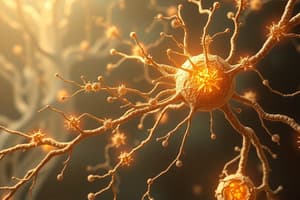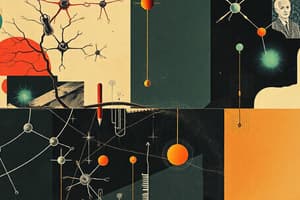Podcast
Questions and Answers
What is the average resting membrane potential of cells?
What is the average resting membrane potential of cells?
- -30 mV
- 0 mV
- -70 mV (correct)
- -90 mV
Which process is primarily responsible for maintaining the resting potential of a neuron?
Which process is primarily responsible for maintaining the resting potential of a neuron?
- Sodium potassium pump (correct)
- Endocytosis
- Facilitated diffusion
- Passive transport
What occurs when the membrane potential reaches a threshold of -50 mV?
What occurs when the membrane potential reaches a threshold of -50 mV?
- Sodium channels close
- The neuron becomes hyperpolarized
- An action potential is generated (correct)
- Repolarization begins
During depolarization in action potential, which ion primarily floods into the neuron?
During depolarization in action potential, which ion primarily floods into the neuron?
What is the main function of the cerebrospinal fluid?
What is the main function of the cerebrospinal fluid?
What is hyperpolarization in the context of action potentials?
What is hyperpolarization in the context of action potentials?
Which protective layer under the skull is filled with cerebrospinal fluid?
Which protective layer under the skull is filled with cerebrospinal fluid?
Which event follows the closing of sodium channels during an action potential?
Which event follows the closing of sodium channels during an action potential?
What is the primary function of the somatic nervous system?
What is the primary function of the somatic nervous system?
Which of the following statements is true regarding the autonomic nervous system?
Which of the following statements is true regarding the autonomic nervous system?
How are the sympathetic and parasympathetic nervous systems primarily different in their actions?
How are the sympathetic and parasympathetic nervous systems primarily different in their actions?
In the autonomic nervous system, where do synapses typically occur in the parasympathetic division?
In the autonomic nervous system, where do synapses typically occur in the parasympathetic division?
What is the role of ganglia within the nervous system?
What is the role of ganglia within the nervous system?
What is the function of astrocytes in the brain?
What is the function of astrocytes in the brain?
Which part of the brain is primarily responsible for regulating homeostasis?
Which part of the brain is primarily responsible for regulating homeostasis?
What is the primary function of microglia in the brain?
What is the primary function of microglia in the brain?
Which lobe of the brain controls vision?
Which lobe of the brain controls vision?
In terms of spinal cord anatomy, where does sensory input enter?
In terms of spinal cord anatomy, where does sensory input enter?
What composes the grey matter in the spinal cord?
What composes the grey matter in the spinal cord?
Which component of the nervous system is responsible for decision making and rational thinking?
Which component of the nervous system is responsible for decision making and rational thinking?
Which type of glial cell is responsible for wrapping neurons in myelin sheath?
Which type of glial cell is responsible for wrapping neurons in myelin sheath?
What is the primary role of the ganglia in the peripheral nervous system?
What is the primary role of the ganglia in the peripheral nervous system?
Which characteristic differentiates the autonomic nervous system from the somatic nervous system?
Which characteristic differentiates the autonomic nervous system from the somatic nervous system?
In the peripheral nervous system, where do sympathetic neurons typically synapse?
In the peripheral nervous system, where do sympathetic neurons typically synapse?
Which of the following describes the function of the enteric nervous system?
Which of the following describes the function of the enteric nervous system?
What happens to postganglionic neurons in the parasympathetic nervous system?
What happens to postganglionic neurons in the parasympathetic nervous system?
What is the main role of astrocytes in the brain?
What is the main role of astrocytes in the brain?
Which part of the brain acts as a relay station between the cortex and the rest of the nervous system?
Which part of the brain acts as a relay station between the cortex and the rest of the nervous system?
What types of cells make up 95% of the brain's cellular composition?
What types of cells make up 95% of the brain's cellular composition?
Which lobe of the brain is primarily responsible for decision making and rational thinking?
Which lobe of the brain is primarily responsible for decision making and rational thinking?
What is the function of the cerebellum in the brain?
What is the function of the cerebellum in the brain?
In the spinal cord, which segment contains motor neurons?
In the spinal cord, which segment contains motor neurons?
What structures are referred to as gyri in the outer view of the brain?
What structures are referred to as gyri in the outer view of the brain?
Which type of glial cell is responsible for insulating neurons with myelin sheath?
Which type of glial cell is responsible for insulating neurons with myelin sheath?
What role does the sodium-potassium pump play in maintaining membrane potential?
What role does the sodium-potassium pump play in maintaining membrane potential?
Which statement best describes depolarization during an action potential?
Which statement best describes depolarization during an action potential?
When does hyperpolarization occur in the action potential process?
When does hyperpolarization occur in the action potential process?
What occurs when the membrane potential is more permeable to potassium?
What occurs when the membrane potential is more permeable to potassium?
What is the significance of the voltage gradient created in the membrane potential?
What is the significance of the voltage gradient created in the membrane potential?
What triggers the generation of an action potential in a neuron?
What triggers the generation of an action potential in a neuron?
Which layer of protection surrounds the brain and spinal cord and contains cerebrospinal fluid?
Which layer of protection surrounds the brain and spinal cord and contains cerebrospinal fluid?
What is indicated by the spikes and dips seen in a graph of action potentials?
What is indicated by the spikes and dips seen in a graph of action potentials?
Flashcards
Membrane Potential
Membrane Potential
The voltage difference across a cell membrane at a given moment.
Resting Potential
Resting Potential
The membrane potential of a cell when not actively transmitting signals; approximately -70mV.
Action Potential
Action Potential
A rapid, temporary change in membrane potential, a nerve impulse.
Sodium-Potassium Pump
Sodium-Potassium Pump
Signup and view all the flashcards
Depolarization
Depolarization
Signup and view all the flashcards
Repolarization
Repolarization
Signup and view all the flashcards
Threshold Value
Threshold Value
Signup and view all the flashcards
Neurons
Neurons
Signup and view all the flashcards
Brain cell types
Brain cell types
Signup and view all the flashcards
Neuron structure
Neuron structure
Signup and view all the flashcards
Glial cell function
Glial cell function
Signup and view all the flashcards
Astrocyte function
Astrocyte function
Signup and view all the flashcards
Oligodendrocytes function
Oligodendrocytes function
Signup and view all the flashcards
Spinal cord segments
Spinal cord segments
Signup and view all the flashcards
Grey matter vs white matter
Grey matter vs white matter
Signup and view all the flashcards
Spinal cord roots
Spinal cord roots
Signup and view all the flashcards
Peripheral Nervous System
Peripheral Nervous System
Signup and view all the flashcards
Somatic Nervous System
Somatic Nervous System
Signup and view all the flashcards
Autonomic Nervous System
Autonomic Nervous System
Signup and view all the flashcards
Sympathetic Nervous System
Sympathetic Nervous System
Signup and view all the flashcards
Parasympathetic Nervous System
Parasympathetic Nervous System
Signup and view all the flashcards
Hyperpolarization
Hyperpolarization
Signup and view all the flashcards
Glial Cells
Glial Cells
Signup and view all the flashcards
Astrocytes
Astrocytes
Signup and view all the flashcards
Oligodendrocytes
Oligodendrocytes
Signup and view all the flashcards
Microglia
Microglia
Signup and view all the flashcards
Brain Lobes
Brain Lobes
Signup and view all the flashcards
Sulci and Gyri
Sulci and Gyri
Signup and view all the flashcards
Study Notes
Nervous System Communication
- Nervous system communication relies on adaptations of different cell types for immunity and nerve impulse generation.
- Membrane potential is the electrical difference/voltage across a cell membrane at a given moment, constantly fluctuating.
- Resting membrane potential averages -70mV, maintained by an imbalance of charged particles inside and outside the cell.
Membrane Potential
- Resting potential is the electrical potential difference across a cell membrane when not actively firing.
- Sodium-potassium pump plays a crucial, active transport role. It expels sodium ions from the cell and pumps potassium ions into the cell, creating an imbalance. This imbalance directly contributes to the resting membrane potential. (3 sodiums are pumped out for every 2 potassium ions pumped in.)
- Membrane permeability differs for sodium and potassium ions at rest. The membrane is more permeable to potassium, allowing potassium ions to leak out, making the inside of the cell more negative, creating a substantial voltage gradient.
- The concentration gradient pushes potassium ions out of the cell, further increasing the voltage gradient.
- Sodium ions are drawn into the cell due to the voltage gradient, balancing the potential.
- Equilibrium potential describes the point at which the concentration gradient and electrical forces balance out to prevent further net movement of ions.
- Depolarization is an increase in membrane potential. It's caused by sodium channels opening, sodium floods in, and the membrane becomes more positive.
- Repolarization occurs when sodium channels close, preventing sodium influx, decreasing membrane potential back towards resting potential.
- Hyperpolarization (Slight increase) happens when extra potassium channels open causing potassium ions to leave the cell, making the membrane more negative than it was at rest.
Neurons
- Neurons are electrically excitable cells, responding to inputs by transmitting electrical signals along their axons.
- Action potentials are temporary reversals in the membrane potential. An axon that is depolarised above -50mV (threshold value) will initiate an action potential leading to a nerve impulse.
- Action potentials are a momentary reversal of electrical potential.
Brain Structure and Function
- The brain is protected by bone (skull) and vertebrae.
- The brain is primarily composed of two types of cells: neurons and glial cells (95% glial cells, 5% neurons).
- Three main types of glial cells: Astrocytes (star-shaped cells that feed neurons and manage the cellular environment), Oligodendrocytes (produce myelin sheaths insulating neurons), and Microlia (immune cells detecting and engulfing invaders).
- Cortex (outer layer) of the brain is responsible for higher-level functions like memory, thinking, and control of the body.
- Hypothalamus regulates homeostasis (stability), and the pituitary gland connects the nervous system and endocrine system.
- The thalamus is a relay station for sensory information; the cerebellum controls motor movement.
- Four main sections/lobes of the brain: Frontal (decision-making and thinking), Parietal (sensory processing), Temporal (hearing), and Occipital (vision).
- Spinal cord contains sensory (Dorsal) and motor(Ventral) neurons and is organized into segments.
- White matter, where neurons carry signals, consist of axons covered by myelin sheaths.
- Grey matter consists of neurons, dendrites, and synapses.
- The spinal cord is segmented, with each segment corresponding to a specific area of the body.
- Each segment contains sensory and motor neurons linked to a distinct section/dermatome.
- The spinal cord is further protected by layers of membrane, called the meninges (Dura, arachnoid and pia mater).
- Spinal cord also has a central canal surrounded by Pia mater that contains cerebrospinal fluid (CSF).
- The spinal cord is also structured in layers called Lamina/Rexed layers and contains nuclei to process information.
Studying That Suits You
Use AI to generate personalized quizzes and flashcards to suit your learning preferences.
Related Documents
Description
This quiz covers the fundamentals of nervous system communication, focusing on cell adaptations for immunity and nerve impulse generation. It also delves into membrane potential, including resting potential and the role of the sodium-potassium pump. Test your understanding of these key concepts in neurobiology.




